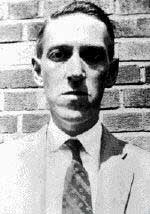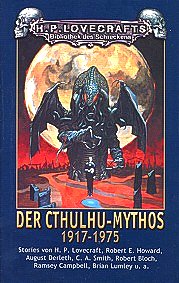
Search
Categories
Famous Authors
Top Selling Books

Book Home
![]() Books Information
Books Information![]() Arcane literature
Arcane literature
Arcane literature (Cthulhu mythos)

Many fictional works of arcane literature appear in the Cthulhu mythos of H. P. Lovecraft. Preeminent among these books are the Necronomicon and the Pnakotic Manuscripts, both the creations of Lovecraft. These tomes and others appear in the works of numerous mythos authors (who themselves added their own grimoires to the literary arcana), including August Derleth, Lin Carter, Brian Lumley, Ramsey Campbell, and Clark Ashton Smith.

Arcane literature in the
mythos
Celaeno Fragments
In August Derleth's novel The Trail of Cthulhu, the name "Celaeno" refers to a distant planet that contains a huge library of alien literature. Professor Laban Shrewsbury and
his companions travel to Celaeno several times to escape Cthulhu's minions. Shrewsbury later wrote the Celaeno Fragments, a work based on what he remembered of his translations of the books in the library of Celaeno.
De Vermis Mysteriis
De Vermis Mysteriis (modern title: Mysteries of the Worm) is a grimoire created by Robert Bloch, and is cited in some later mythos stories. The tome first appeared in Bloch's short story "The Shambler from the Stars" (1935) in which a character reads a passage from the book and accidentally summons a star vampire. It is also featured in a Lovecraftian short story by horror writer Stephen King entitled "Jerusalem's Lot" – part of the Night Shift collection. Additionally, the book is referenced (as Des Vermis Mysteriis) in the 2004 movie Hellboy.
De Vermis Mysteriis was written by Ludwig Prinn in a prison in Prague in 1542. This terrible book is believed to contain knowledge that can drive its readers to madness. Although banned by Pope Pius V, copies may yet be found at the Church of Starry Wisdom in Providence, Rhode Island, at the Huntington Library in California, and at Miskatonic University in Arkham.
Eltdown Shards
The Eltdown Shards are mentioned in numerous mythos stories. They are mysterious pottery fragments found in 1882 and named after the place where they were discovered, Eltdown in southern England. The shards date to the Triassic period and are covered with strange symbols thought to be untranslatable. Nonetheless, several authors have penned their own interpretations of the markings, including Gordon Whitney's The Eltdown Shards: A Partial Translation. Many of these works, as well as a number of non-academic versions, have circulated among secretive cults.
Whitney's translation is remarkably similar to the Pnakotic Manuscripts, a tome produced by the Great Race of Yith. The translation describes Yith, the planet from which the Great Race came, and the Great Race's fateful encounter with the Yekubians. A magical formula from the nineteenth shard is for the summoning of the "Warder of Knowledge"; unfortunately, the dismissal portion of the ritual is garbled, so the summoning of this being could prove calamitous. Despite its connections to the Great Race, the Eltdown Shards were most likely incribed by the Elder Things, who probably buried the ceramics in England when it was part of the great supercontinent Pangaea.
Liber Ivonis (Book of Eibon)
The Book of Eibon, that strangest and rarest of occult forgotten volumes, which is said to have come down through a series of manifold translations from a prehistoric original written
in the lost language of Hyperborea.
—Clark Ashton Smith, "Ubbo-Sathla"
The Liber Ivonis, or Book of Eibon, is attributed to Clark Ashton Smith. It appears in a number of Lovecraft's stories, such as "The Haunter Of The Dark" (Liber Ivonis), "Dreams in the Witch-House" (Book of Eibon) and "The Shadow Out of Time" (Book of Eibon).
The book was written by Eibon, a wizard in the land of Hyperborea. It was an immense tome of arcane knowledge that, among other things, contained a detailed account of Eibon's exploits, including his journeys to the Vale of Pnath and the planet Shaggai; his veneration rituals of Zhothaqquah (Eibon's patron deity); and his magical formulae, such as for the slaying of certain otherworldly horrors. Unfortunately, only incomplete fragments of the original are thought to exist, though there are translations in English, French, and Latin – Liber Ivonis is the title of the Latin translation.
The horror film The Beyond, directed by the late Lucio Fulci, features the Book of Eibon, though the film's story is not Lovecraftian. The book's appearance is largely a tribute to Lovecraft.
Necronomicon
The Necronomicon is arguably the most famous (or infamous) of Lovecraft's grimoires. It appears in a number of Lovecraft's stories, as well as in the writings of other authors.
Unaussprechlichen Kulten
Unaussprechlichen Kulten is said to be written by Friedrich von Junzt. It is also sometimes called The Black Book. The first mention of the book appears in Robert E. Howard's short
story "The Children of the Night" as Nameless Cults. Like the Necronomicon, it is mentioned in several stories by Lovecraft.
Unaussprechlichen Kulten supposedly means "nameless cults" in German, but in fact translates to "unspeakable/unutterable cults". The full title should technically be Von Unaussprechlichen Kulten ("Of Unspeakable Cults") – without the preposition, the German dative case makes no sense, as "Unspeakable Cults" translates to " Unaussprechliche Kulte" (in the nominative). When Lovecraft tried to find a German name for Nameless Cults, Derleth finally came up with Unaussprechlichen Kulten, although the German is not a direct translation. (For the curious, a German translation of Nameless Cults would be Namenlose Kulte.)